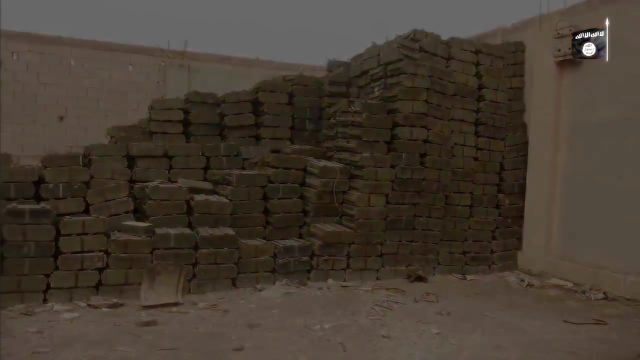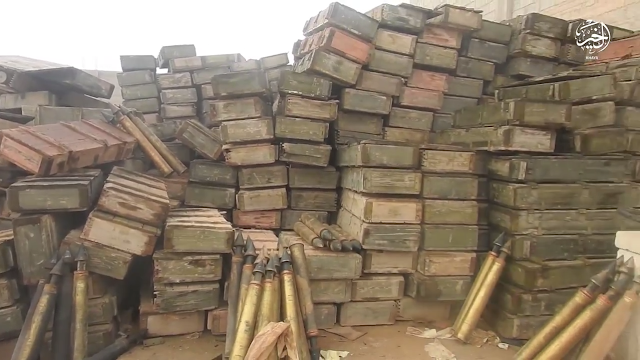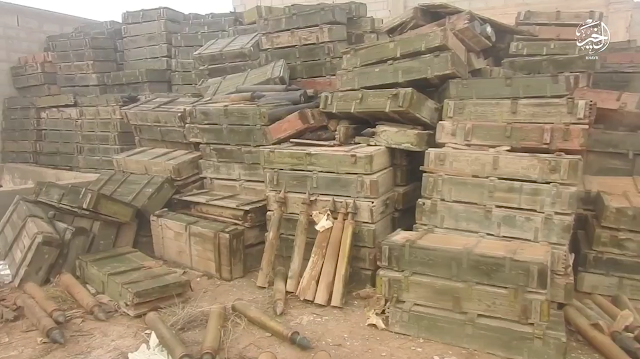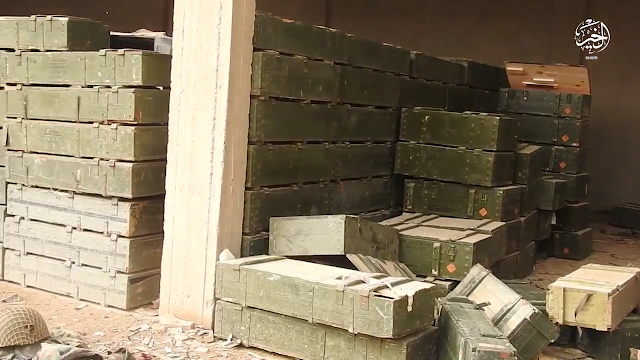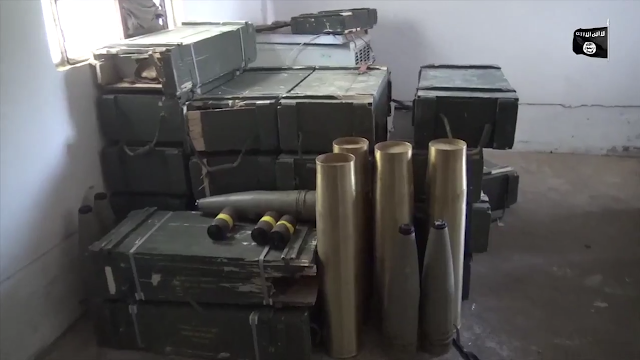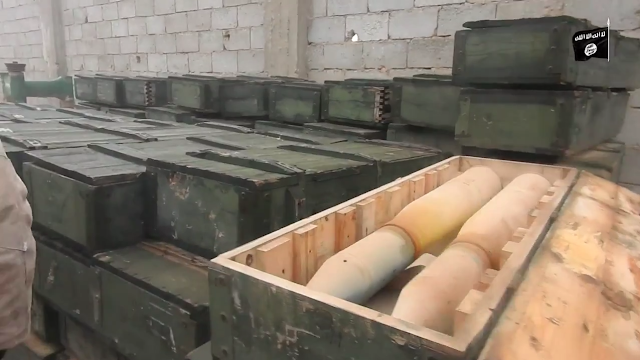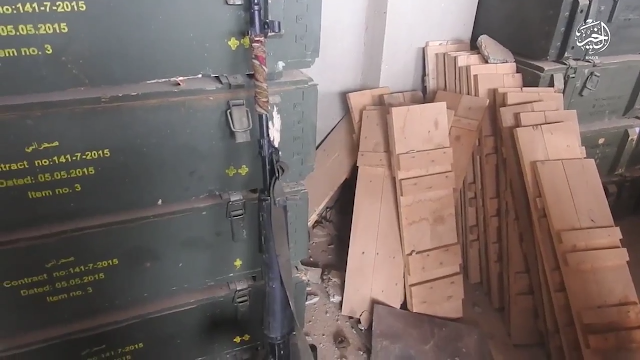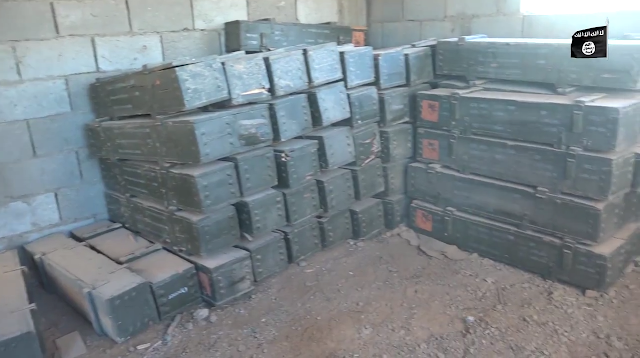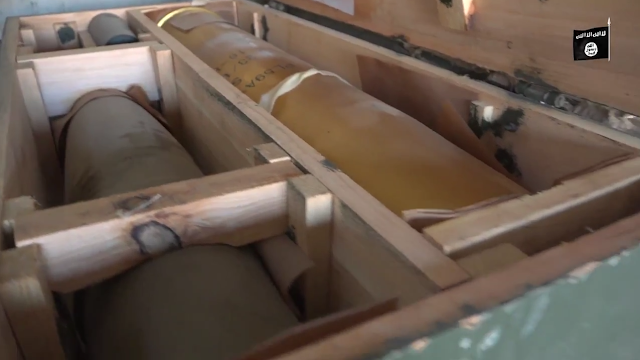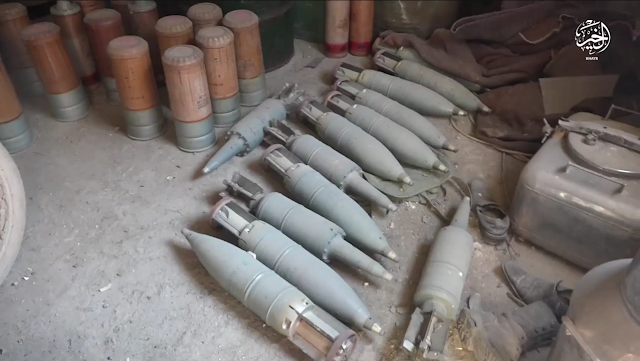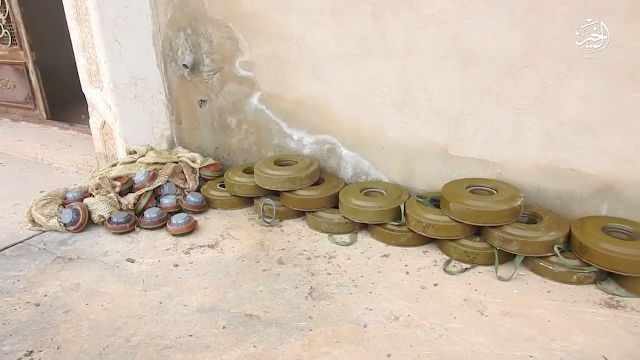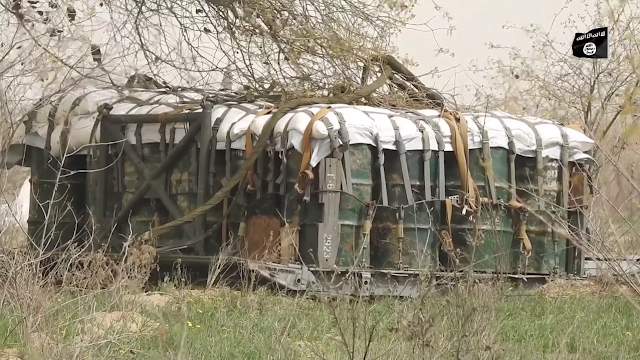By Stijn Mitzer and Joost Oliemans
Just over a year after capturing Deir ez-Zor’s Ayyash weapon depot in the largest arms haul of the Syrian Civil War, the Islamic State has once again got its hands on massive quantities of ammunition captured from a storage depot in Deir ez-Zor. This arms haul joins the list of other major instances where vast amounts of weaponry and munitions traded owners such as the capture of the aforementioned Ayyash weapon depot, Regiment 121, Brigade 93 and the Mahin arms depot, all but the last of which were at the hands of the Islamic State. Each of these depots provided its capturers with a wide array of weaponry, vehicles and ammunition that could immediately be used against their former owners, a major blow to other factions fighting for control over Syria.
A propaganda video released by the Islamic State, showing its fighters on the offensive in Deir ez-Zor, was the only footage released of the capture of the depot. The video, على أبواب الملاحم – ‘At the Doors of Epics [Battles]’, details the Islamic State’s efforts towards splitting the regime-held territory in two, which they succeeded in doing so in February 2017. This means that the airbase and Brigade 137 are now completely isolated, further complicating efforts to supply both pockets and drastically increasing the vulnerability of the airbase. Despite the growing threat, it remains unlikely that the Islamic State will be able to capture either pocket. The capture of significant quantities of ammunition, including up to three million rounds of small arms rounds will surely allow the Islamic State to prolong its fight for survival.
This is an estimate of the ammunition captured, the real figures are believed to be higher. The contents of at least 652 crates could not be identified. Small arms are not included due to the small quantities captured.
Ammunition:
˜ 3,320,600* rounds of 7.62×39, 7.62x54R, 12.7mm and 14.5mm ammunition.
– 2,310 rounds of 85mm ammunition.
– 693 rounds of 100mm ammunition.
– 13 rounds of 125mm ammunition.
– 120 rounds of 120mm ammunition.
– 68 rounds of 122mm rocket ammunition.
– 15 TM-62 anti-tank mines.
Vehicles:
– 1 T-72M1 TURMS-T.
– 3 T-72M1s.
– 1 AMB-S.
– 1 Tatra 148.
– 1 UAZ-469.
– 5 cars.
Although assessing the exact contents of each spam can of small arms munition is impossible, by volume the total amount would equal roughly 3.32 million rounds of 7.62x39mm, or a slightly smaller numer distributed of larger calibres such as 12.7mm and 14.5mm. Regardless, truly a tremendous amount of small arms ammunition was captured indeed.
An immense quantity of 85mm UBR-365P AP rounds was also discovered in the arms depot. While certainly an impressive sight, these rounds are completely useless to the Islamic State. The 85mm D-44 anti-tank cannon currently is the only weapon in the Syrian arsenal capable of firing these rounds, but only a small number of these are active on the battlefield. In fact, the D-44 is so rare the Islamic State is currently believed to be in the possession of just one.
At least 693 rounds of 100mm tank ammunition were also found stored in two seperate rooms. This quantity far exceeds the need of the Islamic State in the city of Deir ez-Zor as it only operates several T-55 tanks that use these shells here. It is thus extremely likely that at least a part was transported to Raqqa for further distribution among Islamic State units elsewhere.
The presence of Iranian ammunition crates dated the 5th of May 2015 is notable, dating back to shortly before the encirclement of the city. These crates likely arrived onboard of one of the SyAAF’s Il-76s that frequently visisted Deir ez-Zor when it was still possible for these aircraft to land at the airbase. This has meanwhile become impossible due to the close proximity of the Islamic State to the runway from the Eastern and Southern side, a fact that was made painfully clear by the destruction of two L-39s in their Hardened Aircraft Shelter (HAS).
Much of the ammunition was quickly loaded onto trucks and cars, and was likely distributed among Islamic State units located throughout Syria. The targeting of these stockpiles before would prevent this from happening, and limit the Islamic State’s ability to continue replenishing its stocks. Nonetheless, such action has time and again not been undertaken by either the SyAAF or Russian Air Force, which combined with the lack of timely evacuation or sabotage of such depots by ground units in the first place has been a major boon to opposing parties during the Syrian War.
The Islamic State also captured two airdrops destined for regime forces in the city, one of which was already believed to have been emptied of its contents before the Islamic State arrived. However, it is extremely likely that the ammunition from these crates was later encountered in one of the depots captured. Several airdrops have so far ended up in the wrong hands after landing in Islamic State controlled territory, which includes the two pallets below.
While a less than ideal situation, these airdrops are meanwhile the only way to supply the city and its inhabitants after the complete encirclement of Deir ez-Zor in May 2015. Both the United Nations and Russian Air Force have actively participated in dropping humanitarian aid to the starving population living in regime-held parts of the city, while Il-76s of the SyAAF are mostly active for the purpose of supplying weaponry, ammunition and fuel to the remaining regime forces held up in the city.
In addition to capturing huge amounts of ammunition, the offensive also provided the Islamic State with four T-72M1s, more than doubling the size of the T-72 fleet the Islamic State currently operates in and around Deir ez-Zor. This arms haul also included a single T-72M1 equipped with the Italian TURMS-T (Tank Universal Reconfiguration Modular System T-series) fire-control system, amounting the first T-72 TURMS-T to have been captured by the Islamic State.
Interestingly, two of the T-72M1s feature protective covers around their TPN-1-49 gunner sights, a modification that is slowly being applied across what remains of Syria’s battered T-72 fleet. A single Czechoslovak AMB-S armoured utility vehicle was also captured, which will likely end up employed as a VBIED similar to the two BREM-2 armoured recovery vehicles captured near the Ayyash weapon depots.
Article written in collaboration with MENA_Conflict.
Recommended Articles
Islamic State captures Ayyash weapons depots in largest arms haul of Syrian Civil War
Armour in the Islamic State, the DIY works of Wilayat al-Khayr




